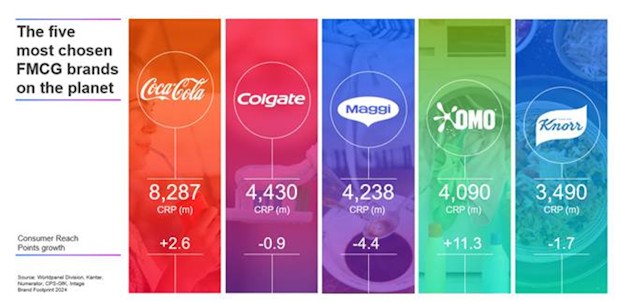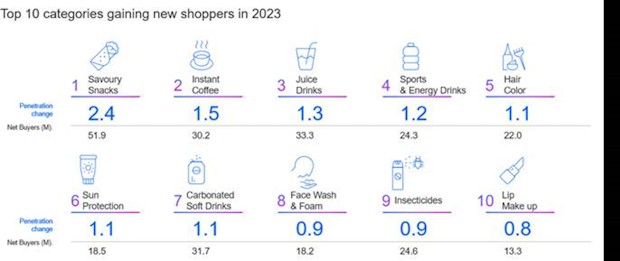Kantar has published its world’s most chosen FMCG brands ranking and laid out its view of how shopper behaviour evolved in 2023.
With the global FMCG inflation rate halving from 8.4% in 2022 to 4% in 2023, shoppers started mixing treating and premium purchases alongside the coping strategies of 2022. Brand Footprint, Kantar’s analysis of consumer behaviour in 62 major markets, reveals that average grocery spend per household around the world exceeded $1,000 for the first time on record, almost 60% more than was spent a decade earlier in 2013.
The Kantar study unpacks the 460 billion brand choices made by shoppers last year – an average of 29 brand decisions each month – to reveal the headwinds facing FMCG brands. Of all FMCG purchases made in 2023, global brands represented 30% of sales value, unchanged vs 2022. Local and regional brands represented 47% of purchases, while private label sales increased by 0.5 percentage points to reach 22.7%.
Discount retailers achieved 10.5% value growth year-on-year on a global basis to represent 16% of all grocery spend, compared to 9.6% in 2021. Globally, 61% of households stated that they were extremely or very concerned with rising grocery costs. As a result, while 64% of global brands grew in value terms, only half of FMCG brands grew in terms of consumer choices – how many times they are chosen off the shelf by consumers.
The world’s most chosen brands last year were Coca-Cola, Colgate, Maggi, OMO and Knorr. In the 12th consecutive year since the study began, Coca-Cola reigned supreme, with a staggering 8.3 billion Consumer Reach Points (CRPs). Meanwhile, Colgate set a benchmark for global penetration, being the only consumer goods brand purchased by over half of the global population, boasting a penetration rate of 55.9%.

Further down the ranking, Red Bull emerged as the year’s standout performer. With a 17.8% increase in CRP, it climbed four spots to 20th place, a testament to its growing appeal and strategic market manoeuvres, such as new product development. Purchased by 9.6% of households across the world, it was picked from the shelves 1.4 billion times.
An analysis of the FMCG categories that are attracting new shoppers reveals a trend of buying more caffeinated drinks. Instant coffee saw 1.5% penetration growth year-on-year (purchased by 30.2m shoppers), sports and energy drinks gained 1.2% penetration growth, or 24.3 million shoppers, and carbonated soft drinks gained 1.1%, equating to 31.7 million new shoppers.

Guillaume Bacuvier, CEO of the Worldpanel Division at Kantar, commented: “The Brand Footprint 2024 rankings reveal how successful brands have recruited more shoppers in an environment where less costs more and private labels are gaining share.
“Put simply, they have found ways to be meaningfully different. It’s what happens when brands create strong functional and emotive connections, making the brand mentally available and physically unavoidable, integrating seamlessly across all consumer touchpoints.
“The brands featured in the report are to be commended for achieving this while pressure on household expenses persists as a stubborn undercurrent in the global economy.”
NAM Implications:
- Whilst respecting what is great about being a big iconic brand…
- …lesser players best make line-by-line comparisons…
- …in search of opportunities the major brands cannot optimise:
- Corporate culture
- Lack of scale
- Lack of coverage
- …and go for it.



